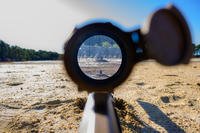Last December, the Marine Corps wowed a small audience in Quantico, Virginia, with a demonstration of a fully autonomous UH-1 Huey helicopter that could navigate, conduct pre-set missions, and even assess landing conditions, all without a human in the loop.
The secret ingredient was the Autonomous Aerial Cargo/Utility System, or AACUS, a kit that can be mounted on a rotary-wing aircraft to transform it from a manned aircraft to an autonomous one. And now, AACUS is a finalist for an elite aviation award.
According to the Office of Naval Research, which leads the AACUS program, it's now a finalist for the 2017 Robert J. Collier trophy, awarded by the National Aeronautic Association for "the greatest achievement in aeronautics or astronautics in America, with respect to improving the performance, efficiency, and safety of air or space vehicles, the value of which has been thoroughly demonstrated by actual use during the preceding year."
Previous recipients have included the NASA/JPL Mars Science Laboratory and Curiosity Project Team; the X-47B, developed by Northrop Grumman and the Navy as a carrier-based unmanned aerial vehicle, and still reportedly in the running for the MQ-25 program; and the team that designed the F-22 Raptor, among others.
"We at ONR are very excited and proud of the AACUS team that was selected as a finalist for this very prestigious Collier Trophy," Dr. Knox Millsaps, director of the division of Aerospace Sciences in ONR's Naval Air Warfare and Weapons Department, said in a statement released by ONR. "But our greatest sense of excitement and pride comes knowing we've provided a technology that could help the Marine Corps warfighter stay out of harm's way during resupply missions."
AACUS, which is designed to be so easy to use that a Marine can program a mission after a few minutes of training, is expected to be an asset for logistics and resupply missions, providing a way to get beans, bullets, medical supplies and more to units downrange without risking a human pilot and crew.
The Corps next plans to place the technology in units for realistic testing as part of its Sea Dragon 2025 experimentation effort later this fiscal year.
The AACUS is competing against eight other finalists for the Collier trophy, according to the ONR announcement.
They include: Boeing 737 MAX; Cirrus Aircraft Vision SF50; Edwards Air Force Base F-35 Integrated Test Force; NASA/JPL Cassini Project Team; Perlan Project; TSA, ALPA and A4A Known Crewmember and TSA PreCheck Programs; Vanilla Aircraft VA001; and Zee Aero Division of Kitty Hawk Corporation.
A winner is expected to be announced March 23.
-- Hope Hodge Seck can be reached at Hope.Seck@military.com. Follow her on Twitter at @HopeSeck.










